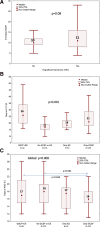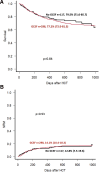Impact of Granulocyte Colony-Stimulating Factor (G-CSF) on Clinical Outcomes in Allogeneic Hematopoietic Cell Transplantation: Does Speeding Up Neutrophil Engraftment Make a Difference?
- PMID: 39802196
- PMCID: PMC11723673
- DOI: 10.1097/TXD.0000000000001753
Impact of Granulocyte Colony-Stimulating Factor (G-CSF) on Clinical Outcomes in Allogeneic Hematopoietic Cell Transplantation: Does Speeding Up Neutrophil Engraftment Make a Difference?
Abstract
Background: Despite decades of post-allogeneic hematopoietic cell transplantation (HCT) growth factor utilization, its role remains undefined, leading to ongoing debates and research. The theoretical impacts of growth factors have been challenged in numerous studies.
Methods: In this retrospective cohort study conducted at the Princess Margaret Cancer Centre, we analyzed the clinical outcomes of 509 patients who underwent allogeneic HCT between May 1, 2019, and May 31, 2022. This study aimed to assess the impact of granulocyte colony-stimulating factor (G-CSF) administration posttransplantation on neutrophil and platelet engraftment, incidence of bloodstream infections (BSIs), graft-versus-host disease, engraftment syndrome (ES), and survival metrics including overall survival, nonrelapse mortality, and graft-versus-host disease-free/relapse-free survival.
Results: Our findings indicate that G-CSF administration expedited neutrophil engraftment (16 versus 18 d, P = 0.009) and was associated with a decreased incidence of BSI (9.4% versus 31.3%, P = 0.014). However, this benefit was counterbalanced by a significant delay in platelet engraftment (21 versus 17 d, P < 0.001). Multivariate logistic regression analysis identified mismatched donors (odds ratio, 1.72; 95% confidence interval, 1.03-2.88; P = 0.038) and the duration of G-CSF therapy (odds ratio, 1.04; 95% confidence interval, 1.00-1.09; P = 0.038) as independent predictors for the development of ES. Despite these hematological impacts, there was no observed advantage in overall survival, nonrelapse mortality, or graft-versus-host disease-free/relapse-free survival among patients who received G-CSF compared with those who did not.
Conclusions: Although G-CSF post-HCT expedited neutrophil engraftment and reduced BSI risk, it did not result in a survival advantage. The association with ES necessitates careful consideration.
Copyright © 2025 The Author(s). Transplantation Direct. Published by Wolters Kluwer Health, Inc.
Figures




Similar articles
-
Planned Granulocyte Colony-Stimulating Factor Adversely Impacts Survival after Allogeneic Hematopoietic Cell Transplantation Performed with Thymoglobulin for Myeloid Malignancy.Transplant Cell Ther. 2021 Dec;27(12):993.e1-993.e8. doi: 10.1016/j.jtct.2021.08.031. Epub 2021 Oct 2. Transplant Cell Ther. 2021. PMID: 34507002 Free PMC article.
-
Comparison of outcome of allogeneic bone marrow transplantation with and without granulocyte colony-stimulating factor (lenograstim) donor-marrow priming in patients with chronic myelogenous leukemia.Biol Blood Marrow Transplant. 2002;8(5):261-7. doi: 10.1053/bbmt.2002.v8.pm12064363. Biol Blood Marrow Transplant. 2002. PMID: 12064363 Clinical Trial.
-
The effect of G-CSF used after allogeneic hematopoietic stem cell transplantation on engraftment times and platelet suspension replacement numbers.Transfus Apher Sci. 2022 Dec;61(6):103482. doi: 10.1016/j.transci.2022.103482. Epub 2022 Jun 7. Transfus Apher Sci. 2022. PMID: 35718683
-
Impact of G-CSF administration post-allogeneic hematopoietic stem-cell transplantation on outcomes: a systematic review and meta-analysis.Am J Blood Res. 2021 Oct 15;11(5):544-563. eCollection 2021. Am J Blood Res. 2021. PMID: 34824887 Free PMC article. Review.
-
Clinical use of hematopoietic growth factors in allogeneic bone marrow transplantation.Blood Rev. 1994 Sep;8(3):169-78. doi: 10.1016/0268-960x(94)90078-v. Blood Rev. 1994. PMID: 7529606 Review.
References
-
- Ringdén OTH, Le Blanc K, Remberger M. Granulocyte and granulocyte-macrophage colony-stimulating factors in allografts: uses, misuses, misconceptions, and future applications. Exp Hematol. 2005;33:505–512. - PubMed
-
- Hägglund H Ringdén O Man SO¨, et al. . A prospective randomized trial of Filgrastim (r-MetHuG-CSF) given at different times after unrelated bone marrow transplantation. 1999;24:831–836. - PubMed
-
- Stinson TJ, Adams JR, Bishop MR, et al. . Economic analysis of a phase III study of G-CSF vs placebo following allogeneic blood stem cell transplantation. Bone Marrow Transplant. 2000;26:663–666. - PubMed
-
- Bishop MR, Tarantolo SR, Geller RB, et al. . A randomized, double-blind trial of Filgrastim (granulocyte colony-stimulating factor) versus placebo following allogeneic blood stem cell transplantation. Blood. 96:80–85. - PubMed
-
- Przepiorka D, Smith TL, Folloder J, et al. . Controlled trial of Filgrastim for acceleration of neutrophil recovery after allogeneic blood stem cell transplantation from human leukocyte antigen-matched related donors. Blood. 2001;97(11):3405-3410. - PubMed
LinkOut - more resources
Full Text Sources

